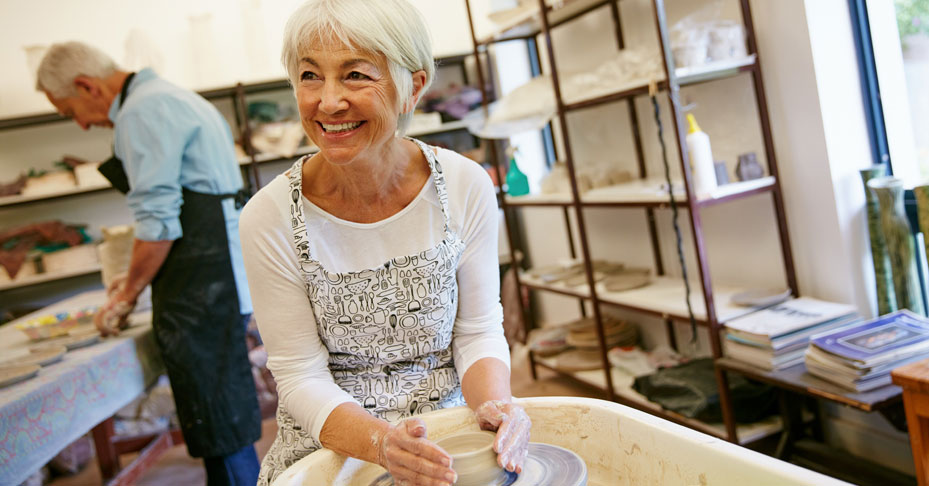This article was originally published in 2018, but it has since been updated to reflect new research and consumer trends. A lot has changed since we first covered this topic, but the value of marketing to seniors has not!
The senior citizen segment is made up of over 50 million people in the US alone. They have a large amount of disposable income, they’re looking for guidance to help live longer, healthier lives, and they’re open to a properly delivered marketing message. Marketing to them shouldn’t be a passing thought—it should be considered for every major campaign.
The Senior Demographic
While it’s easy to think of the senior market as one population segment, it comprises four major groups:
- Pre-Retirees (50-65): The term senior generally starts at 55 years of age and up, but many people turning 50 are also planning for retirement. Additionally, younger spouses (ages 45-54) married to older retirees are often ready to make financial changes and pre-retirement decisions.
- Grandparents and Relatives (50+): Grandparents and older family members deserve separate segmentation because they often spend considerable money on relatives and respond well to targeted advertisements.
- Late Retirees (65-75): Similarly to pre-retirees, this segment encompasses age groups above the standard retirement age who are still working.
- Active Retirees (65+): This group of seniors no longer earns active income. Their money is sourced from savings, assets, Social Security, pensions, and more. They live on a “fixed income.”
Senior Citizen Spending Power
The senior population is growing in both size and spending power, with the number of older adults going up 3.2% every year. In 2022, there are over 56 million seniors in the US.
Seniors are a lucrative target audience, with $3.2 trillion in spending power. Consumers aged 50+ are responsible for 51% of consumer spending, and baby boomers (born between 1946-1964) control over 50% of all the wealth in the United States, with a total net worth of close to $70 trillion. In short, senior citizens have 5x the net worth of the average American.
Earlier generations have operated on the assumption that their children will earn higher wages and live better lives, but millennials (born 1981 to 1995) have bucked this trend, and are the first generation to have lower incomes and fewer jobs compared to previous generations. In fact, Baby Boomers hold almost 9x more wealth compared to Millennials and make 20% more online purchases.
By 2023, senior citizen spending is expected to reach almost $15 trillion. On top of this, the global senior population should reach more than 1.5 billion by 2050. But despite this being the wealthiest age group, many marketers are missing out on marketing to seniors.
Marketing Techniques for Seniors
A mature audience is more likely to be influenced by strong, straightforward messaging. Keeping text clear and using relevant, plain language will help. On top of this, there are a number of other important factors when building out a marketing campaign targeting senior citizens:
Simplicity
When developing your programs, keep the user experience simple and straightforward, as you would with any task you ask your buyers to perform. Everything from onboarding to check out should be uncomplicated and easy to use. People over the age of 65 didn’t grow up with technology. This isn’t to say technology should be dismissed as a way of interfacing with seniors, but it’s important to understand how to connect with an older audience without relying solely on technology to drive conversions.
Want to use personalized offers to acquire senior customers?


Exclusivity
Building exclusive offers and promotions targeted towards seniors—such as sale days, free deliveries, and birthday gifts—can be effective. The idea is to run campaigns that give prospective customers a sense of pride and value. This also means assisting customers in sharing offers through word-of-mouth or social media.
Trust
When asking seniors for personal details, make sure they understand why the information is needed and why it will help with their overall experience. It helps to reinforce that their private information is safe and secure. Both testimonials and money back guarantees can also help foster trust.
Personalization
Don’t assume all of your customers are similar because they’re part of the same demographic. Not everyone over the age of 55 likes or cares about the same things. Make it a priority to create marketing personas and customize your segmented marketing with education, cultural upbringing, location, employment status, and more.
Support
Stay in touch with customers even after they’ve made a purchase. The majority want to feel connected and supported by their business, and by acting as a trusted brand, companies can show them that they care. Be responsive and helpful regarding support issues and ensure that their issue won’t sidetrack them again in the future.
Visuals
Image selection is a very important factor when marketing to seniors. A good rule of thumb is that most people see themselves about 5-10 years younger than they are. Keep that in mind when selecting images to accompany any content. The goal is to have clients connect with the person they see in their advertisements.
Best Practices for Reaching Senior Citizens
Seniors aren’t helpless people who can’t make their own decisions. They are often strong, healthy adults who appreciate making their own choices. Don’t direct marketing language towards their caregiving audience or their children in order to sell a product. There are numerous ways to directly target senior citizens, without diluting their sense of independence:
Adjust the Relevant Criteria
When selling a product, the basic goal isn’t to sell the product, but rather, what the product can do for the customer. Senior citizens don’t want the same thing that a teenager wants, but that shouldn’t stop marketers from adjusting their language to provide strong purchasing qualifications for both population segments. A product can be sold to anybody if the marketer can figure out why they would want it.
Use Multi-Channel Marketing
In 2022, 4 out of 5 Americans over the age of 60 own smartphones. Since the number of seniors who are digitally savvy is increasing, marketers need to use a multi-channel approach that includes both more traditional advertising and digital marketing strategies.
Personalize Their Experience
Older audiences are used to quality customer service, before automation and self-service sped up the process. They value being able to reach a real person for their concerns and will likely be more comfortable with phone calls over texts or automated chats.
Retargeting
Seniors respond well to retargeting. It allows marketers to continue reaching seniors who have visited a landing page or expressed interest in a product or service, without ever having followed through.
Value-Added Marketing
When you provide prospects with an added piece that is free, useful, and valuable, you will boost response from seniors. A value added piece can be an objective, informational piece, a small gift, or something useful like a checklist or a calendar. Value added pieces can be offered in direct mail pieces or online.
Educate
Older consumers tend to be slower to purchase, so take the time to help your senior customers understand your product and how it’s used. Because the world and technology have evolved so rapidly, this is especially important with any products that may not have been around when seniors were younger. For instance, a virtual assistant such as Amazon Alexa could be very helpful for seniors, but they might need some extra guidance on learning how to use this technology. Be sure to communicate clearly what the product does before the sale, then continue engaging your customers with content that will help them make the most of it post sale.
Marketing Language
Consider the language used when reaching an older audience. Inundating older customers with words such as “senior citizen” and “elderly” can be detrimental to your marketing strategy. And making older generations feel relevant can be straightforward:
- Don’t use images of older people sitting around using a product—try thinking of ways to show activity.
- Consider the concepts of youth and wisdom. Seniors enjoy being active, taking interesting vacations, doing all the things they wanted to do, or did do, when they were younger. But they also have the foresight to understand when something will make their experience more enjoyable.
- Avoid unnecessary messaging in favor of more thoughtful marketing. Explanations and product endorsements are especially appreciated.
- The mature market is more likely to respond to “reasons why” copywriting. Explainers that help customers make a decision will do better than writing that tries to hype itself or push the mature consumer into buying.
- Researchers have found that 31% more people will believe in a drug advertisement if they see a chart, rather than only a description. Charts will help persuade an otherwise skeptical senior prospect into becoming a customer or client.
How to Reach Seniors
Trying to understand how to reach older generations first means breaking down any stereotypes about senior citizens and technology. It’s bad marketing to assume that senior citizens have issues with technology—they actually spend more time online than millennials, and they represent almost a third of all social media users.
Online Shopping
Many senior citizens use the Internet as their primary means of comparison shopping. Pre-retirees (50-65 years old) shop online with the most confidence of all senior citizens. On top of that, people older than 65 spend an average of $187 per month on online purchases.
Social Media
The senior market is easily identified for marketing purposes. Marketers can target the mature audience in a variety of mediums. Direct mail, email, Facebook, Twitter, and more make it easy to reach this group without wasting money on unwanted segments.
Of all the major social media platforms, Facebook is still the main draw for senior citizens, over Twitter and Instagram. Facebook gives its users a rich feature set for communicating with others, and directly allows people to connect with old friends and family. Because of its ubiquity, older audiences tend to be more familiar with the platform. In 2022, Facebook had over 2 billion monthly active users. More than 70% of seniors have Facebook accounts, and they are very responsive to Facebook advertising.
Facebook retargeting allows marketers to advertise on Facebook to people who have shown previous interest in purchasing. Facebook also offers lead ads for gathering contact info, and Facebook video ads are especially well liked by seniors.
While support of Facebook will continue to grow, there are other platforms that are seeing increasing rates of adoption among senior citizens – Pinterest and YouTube in particular. All the more reason to engage a mature audience on social media.
Native Advertising
Native advertising is material within editorial content that appears similar to the main content while actually being a paid placement. The major benefit of native advertising is that it allows marketers to place content inside platforms with larger audiences. With native advertising, viewers get to consume marketing content natively—as if it’s a part of the site. This means that senior citizens—who appreciate context and want to know that they are reading something they can trust—will have an easier time believing natively placed advertisements.
Mobile Marketing
Designing for mobile platforms has always been important to marketers, but in 2018, it’s becoming even more critical for people trying to reach senior citizens. Mobile marketing is simple, ever-present, and effective. People rely on their mobile devices for many reasons, from convenience to responsiveness. This is especially important for the slightly younger mature demographic—below 70 years old.
4 Excellent Examples of Marketing to Seniors
What does successful marketing to senior campaigns look like? Here are some brands that have cracked the code on engaging older consumers:
Rite Aid
Rite Aid offers a variety of perks for senior citizens through its Rite Aid Rewards 65+ program, including 5x points on purchases and free pharmacy consultations. First Wednesdays of every month are dedicated to seniors, with in-store deals and special activities. Rite Aid also recently partnered with Homeward to help provide medical care for seniors living in rural areas.
L’Oreal
Makeup brand L’Oreal wants seniors to feel beautiful too. L’Oreal’s Age Perfect line caters to the needs of mature skin, and the brand uses mature models and spokespersons for these campaigns, such as Helen Mirren, to make sure seniors feel represented. The website also includes a landing page devoted to diversity that discusses, among other topics, their mission to make all ages feel welcome. The secret to L’Oreal’s successful senior marketing campaign is representing this time of life as glamorous and exciting.
Nike
Sports brand Nike knows that many seniors are quite active and need products catered to their unique needs. That’s why they created the CruzrOne sneaker, a runner shoe for people who need to move at a slower pace. Nike uses a “stealth marketing” strategy in which they don’t specifically mention age when advertising products like the CruzrOne; instead, they emphasize the features of the shoe that would make it perfect for active seniors. This way, their customers don’t feel like they’re being called out for being “old.”
Michaels
Arts and crafts retailer Michaels had a longstanding in-store senior discount of 15%, but when they moved into the ecommerce realm, they reassessed their discounting strategy. For one thing, it was tricky to verify that seniors were, in fact, seniors during checkout because asking for proof of age could seem rude. So, the brand moved its offers online and connected them to its loyalty program, Michaels Rewards. It partnered with SheerID to add instant age verification services that could confirm senior status with minimal personal information. Once verified, seniors can redeem their discount either online or in-store. Michaels’ personalized offers for seniors has helped them acquire and engage members of this valuable community.
Targeting Seniors with Verification Services from SheerID
With SheerID’s Verification Platform, senior citizens can redeem their exclusive offers seamlessly. Our instant, configurable eligibility verification service delivers the most robust, authoritative solution in the industry.
Interested in learning more? Set up a free demo to get started.







